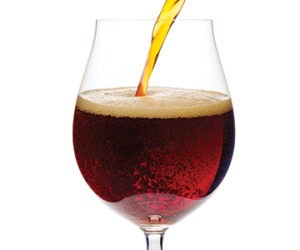Big Beers, Done Right
It’s not too late to brew that big beer for winter; the barleywine, imperial stout, doppelbock, or Belgian quad you’ve dreamed of. If you play your cards right, you should have plenty of time to get one or more out for the season. Many brewers consider these some of the harder styles to brew, but they don’t need to be. So let’s run through some basics of brewing big beers to get a beer you’re proud to sip all winter long.
Yeast Management
I’ll just jump right into the heart of the matter of making imperial-style or high-ABV beers: Happy yeast make good beer. Stressed yeast often throw off-flavors and/or have difficulty finishing fermenting. A recommendation I have for all brewers that don’t have a lot of experience in brewing big beers is to use dry yeast strains. They are easy to use, easy to pitch a proper amount, and you don’t need to aerate the wort (but you should still use a yeast nutrient). SafAle’s US-05, S-04, and BE-256 from Fermentis, LalBrew’s Nottingham, New England, and Abbaye from Lallemand, and Mangrove Jack’s M42, M44, and M41 are all good candidates due to their strong attenuation and alcohol tolerance. Pitching 2–3 sachets per 5 gallons (19 L) should be more than enough to finish a beer to the upper end of the strain’s alcohol tolerance level, oftentimes even higher.

If a liquid strain is preferred, there are several techniques you can employ to build enough yeast to properly ferment high-gravity wort. In my experience, the path of least resistance is to brew a smaller beer (lower-alcohol beer) a week or so prior to your big-beer brew day and repitching the yeast cake (tan sediment at the bottom of the fermenter) into the high-gravity wort. Then you don’t need to deal with oversized starters and the hassles they can entail. There are a lot of calculations that can go into repitching yeast from a yeast cake, but to keep things simple, pitch roughly a pint (500 mL) of the solid material found at the bottom of the fermenter per 5 gallons (19 L) of high-gravity wort. This should provide plenty of healthy, vigorous yeast that are ready for action. But make sure to add some yeast nutrients to the high-gravity wort near the end of the boil and you’ll need to aerate the wort in some fashion. A shot of pure oxygen or a period of filtered air through a carbonation stone is highly recommended to give the yeast a leg up in this stressful, high-sugar environment.
All-Grainers Should Consider Malt Extract
All-grain brewers can be a stubborn bunch. Malt extract is too often viewed as an inferior product or one that they feel below their skill level. That’s all well and good if you want to be a purist in your brewing ways, but when it comes to brewing really big beers, malt extract and simple sugars should be your best friend. My general rule of thumb is to create wort from malt up to about 1.080 (and even then I’m sometimes disappointed by low efficiency), then it’s supplement time. I’ve talked to several elite brewers in the craft beer world about their big imperial stout and have been surprised how many use dried malt extract to gain those extra points above your typical mid-ABV beer and they (and their customers) are 100% happy with the results.
There is another technique known as parti-gyle brewing, which is one I will employ to produce high-gravity wort as well, but that is a rabbit hole I can’t jump down in this article. Digital members can learn more about this historic brewing technique at: https://byo.com/article/introduction-to-parti-gyle-brewing/
Fermentation Thoughts
Some temperature control during fermentation is highly recommended. These fermentations can get vigorous if left unchecked, with the potential for temperatures to get dangerously high during a critical period in the beer’s fermentation cycle. Your goal is to try to maintain the fermenter temperature within the yeast strain’s suggested range. More specifically though, a cooler start to fermentation and warmer end of fermentation is the best way to ensure that the yeast don’t throw unwanted flavors at the beginning of this critical phase or fall out of solution too soon to finish the fermentation.
Aging and Packaging Considerations
Once fermentation is complete there may be several more considerations for your big beer. Many imperial stouts these days feature additions like vanilla beans, cocoa nibs, coffee, or Bourbon-soaked oak that may require extending aging times. Even without those added ingredients, some extra conditioning time is recommended for these big beers. Make sure to rack the beer to a secondary vessel for conditioning if your beer was fermented in a plastic pail, or to get the beer off the yeast, or if you need to free up your primary fermenter. Fermenters with a yeast dump port won’t necessarily need a racking. While there may be some benefits to age a beer like this for long periods of time, you may find that you’re happy with the results not too long after fermentation is complete if you’ve treated the yeast with care. If you do decide to age for a longer period of time or if the beer is a very high-alcohol beer, I definitely recommend pitching a bottle-conditioning strain of yeast (a high-alcohol tolerant strain) if you are not force carbonating.



